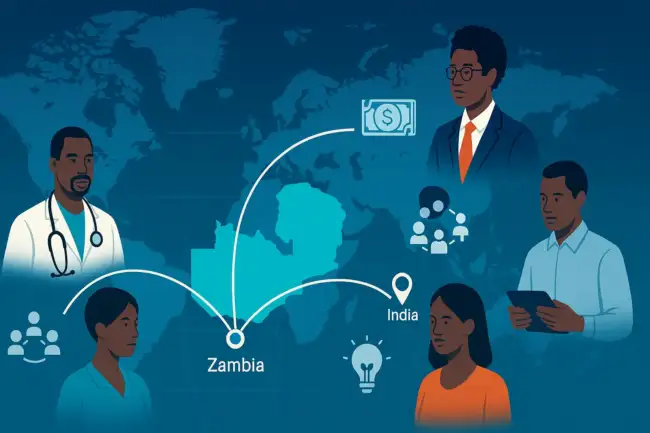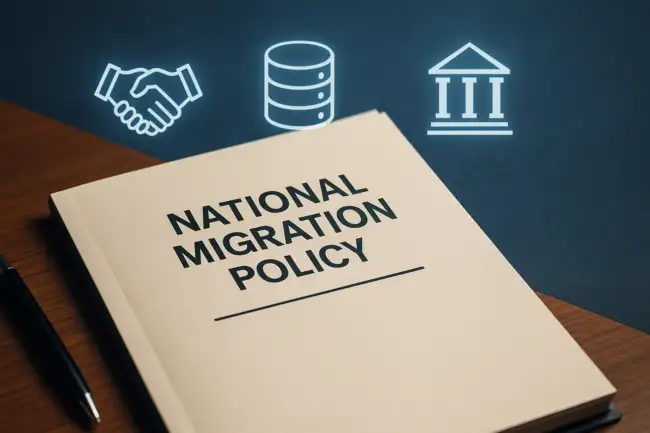Introduction
Irregular migration poses significant legal, economic, and human rights challenges for many countries, and Zambia is no exception. The clandestine nature of irregular migration, which includes unauthorized border crossings, trafficking in persons, and smuggling of migrants, makes it inherently difficult to monitor. Yet, without accurate, up-to-date, and comprehensive data, Zambia cannot hope to craft effective interventions.
This article delves into the core of the issue: the critical absence of robust data systems and coordination mechanisms for tracking irregular migration. It highlights how this gap not only weakens Zambia’s ability to address national security and human trafficking concerns but also undermines regional cooperation and long-term development. By exploring solutions, we argue that migration data must become central to national planning and enforcement strategies.
Understanding Irregular Migration
Irregular migration refers to the movement of people across borders without legal authorization or in violation of the immigration laws of the receiving country. This includes:
- Entering or staying in a country without the necessary documentation
- Using fraudulent documents
- Being trafficked or smuggled
- Overstaying legal permits
Zambia, due to its central location in Southern Africa, is both a source, transit, and destination country for irregular migrants. The porous nature of its borders, combined with limited surveillance and economic disparities, makes it vulnerable to illegal movements.
The Data Void: Zambia’s Achilles Heel
The greatest challenge to combating irregular migration in Zambia lies in the absence of comprehensive, coordinated data. Currently, information on irregular migration is derived from fragmented administrative records, mainly arrests and border interceptions handled by the Department of Immigration.
Key data limitations include:
- Lack of real-time data: Institutions operate reactively, relying on reported incidents.
- Fragmented sources: Data is held in silos by police, immigration, and social welfare agencies without integration.
- Insufficient disaggregation: Existing data does not reflect migrant profiles (age, gender, country of origin, reason for movement).
- No centralized database: There is no unified system for migration-related crime, returnees, or deportations.
The 2019 Migration Profile acknowledged these gaps, and despite some improvement in awareness, implementation of data reforms remains low.
Consequences of Data Gaps on Governance and Protection
- Weak Law Enforcement
Law enforcement agencies cannot detect trends or forecast high-risk routes. Operations are sporadic and reactive rather than proactive. - Human Trafficking and Smuggling
Trafficking networks thrive in the absence of accurate data. Zambia was downgraded to Tier 2 Watch List in the 2020 U.S. Trafficking in Persons (TIP) Report due to its limited ability to identify and protect victims, especially children and women. - Poor Victim Protection Services
Victim support—shelter, legal aid, and rehabilitation—depends on understanding needs. Without disaggregated data, support programs lack focus and funding justification. - Lack of Regional Cooperation
Zambia is part of the Southern African Development Community (SADC), but without reliable data to share, regional migration governance suffers. Joint border control, intelligence exchange, and repatriation coordination are hampered. - Ineffective Policy and Budgeting
Migration policies and budgets are currently not evidence-based. Without reliable figures, the government cannot effectively allocate resources or assess intervention outcomes.
Why a Multisectoral Approach is Key
The cross-cutting nature of irregular migration requires more than just immigration enforcement. It intersects with:
- National security
- Gender and children’s rights
- Labour and employment
- Public health
- Humanitarian protection
Therefore, combating irregular migration requires an integrated system that involves:
- Immigration Department
- Zambia Police Service
- Ministry of Home Affairs and Internal Security
- Ministry of Community Development and Social Services
- Civil Society Organizations (CSOs)
- International agencies (IOM, UNHCR)
Proposed Data and Policy Reforms
- Establish a Central Irregular Migration Database
A national electronic system that collects and integrates data from police, immigration, social services, and border authorities. Include modules for trafficking, smuggling, detention, and returnees. - Introduce Standardized Reporting Tools
All agencies involved in migration enforcement should use standardized forms and indicators for capturing data. This ensures consistency across institutions. - Conduct Periodic National Migration Audits
Go beyond routine interception records by conducting nationwide audits or surveys that capture migration vulnerabilities and hotspots. - Fund and Support Victim Identification Systems
Equip frontline officers with tools to identify potential trafficking victims. Develop a mobile-based victim reporting system for migrants and community members. - Build Analytical Capacity
Train statisticians, immigration officers, and data managers in data science, data ethics, and migration analysis. Create career pathways for migration analysts. - Legal and Policy Harmonization
Align Zambia’s laws on trafficking, smuggling, asylum, and border control to international instruments. Simplify processes for inter-agency collaboration. - Enhance Cross-Border Collaboration
Through SADC and bilateral agreements, establish real-time data sharing mechanisms on irregular migration and trafficking routes.
Conclusion
Zambia’s struggle with irregular migration is not simply a border control issue—it is a governance challenge rooted in information scarcity. Irregular migration thrives in the dark, and the lack of reliable data has become its most powerful shield.
Only by turning on the light through accurate, timely, and shared migration data can Zambia hope to develop effective policies, protect vulnerable individuals, and maintain national and regional security. The road ahead is difficult but necessary. Migration data is no longer a luxury—it is a national development imperative.
Disclaimer: This article is for informational purposes only and does not constitute legal advice. The views expressed are those of the author and do not necessarily reflect the position of YMS Legal.



